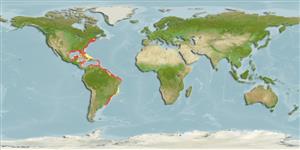>
Anguilliformes (Eels and morays) >
Ophichthidae (Snake eels) > Ophichthinae
Etymology: Ophichthus: Greek, ophis = serpent + Greek, ichthys = fish (Ref. 45335); gomesii: Named for Ildefonso Gomes, a physician who treated Castelnau of a sickness in Rio de Haneiro; noun in genetive case (Ref. 54133).
More on author: Castelnau.
Environment: milieu / climate zone / depth range / distribution range
Écologie
marin démersal; profondeur 1 - 450 m (Ref. 57911), usually 1 - 90 m (Ref. 57911). Tropical; 44°N - 36°S, 98°W - 34°W
Western Atlantic: Massachusetts, USA and northern Gulf of Mexico to southern Brazil; absent in the Bahamas and most Caribbean islands. Northwest Atlantic: Canada (Ref. 5951).
Taille / Poids / Âge
Maturity: Lm ? range ? - ? cm
Max length : 91.4 cm TL mâle / non sexé; (Ref. 26340); common length : 50.0 cm TL mâle / non sexé; (Ref. 3795)
Inhabits soft bottoms. Occurs in bays and backwaters to offshore banks, less commonly to 180 m depth. The most common eel on Florida shrimp grounds. Rarely consumed (Ref. 3795).
Life cycle and mating behavior
Maturité | Reproduction | Frai | Œufs | Fécondité | Larves
Robins, C.R. and G.C. Ray, 1986. A field guide to Atlantic coast fishes of North America. Houghton Mifflin Company, Boston, U.S.A. 354 p. (Ref. 7251)
Statut dans la liste rouge de l'IUCN (Ref. 130435)
Menace pour l'homme
Harmless
Utilisations par l'homme
Pêcheries: pêcheries vivrières
Plus d'informations
Taille/Âge
Croissance
Longueur-poids
Longueur-longueur
Fréquences de longueurs
Morphométrie
Morphologie
Larves
Dynamique des populations larvaires
Recrutement
Abondance
BRUVS
RéférencesAquacultureProfil d'aquacultureSouchesGénétiqueElectrophoresesHéritabilitéPathologiesTraitementNutrientsMass conversion
Outils
Articles particuliers
Télécharger en XML
Sources Internet
Estimates based on models
Preferred temperature (Ref.
123201): 12.4 - 27.8, mean 24.8 °C (based on 1328 cells).
Phylogenetic diversity index (Ref.
82804): PD
50 = 0.5000 [Uniqueness, from 0.5 = low to 2.0 = high].
Bayesian length-weight: a=0.00089 (0.00039 - 0.00204), b=3.00 (2.80 - 3.20), in cm total length, based on LWR estimates for this (Sub)family-body shape (Ref.
93245).
Niveau trophique (Ref.
69278): 4.0 ±0.7 se; based on size and trophs of closest relatives
Résilience (Ref.
120179): Milieu, temps minimum de doublement de population : 1,4 à 4,4 années (Preliminary K or Fecundity.).
Fishing Vulnerability (Ref.
59153): High vulnerability (57 of 100).
